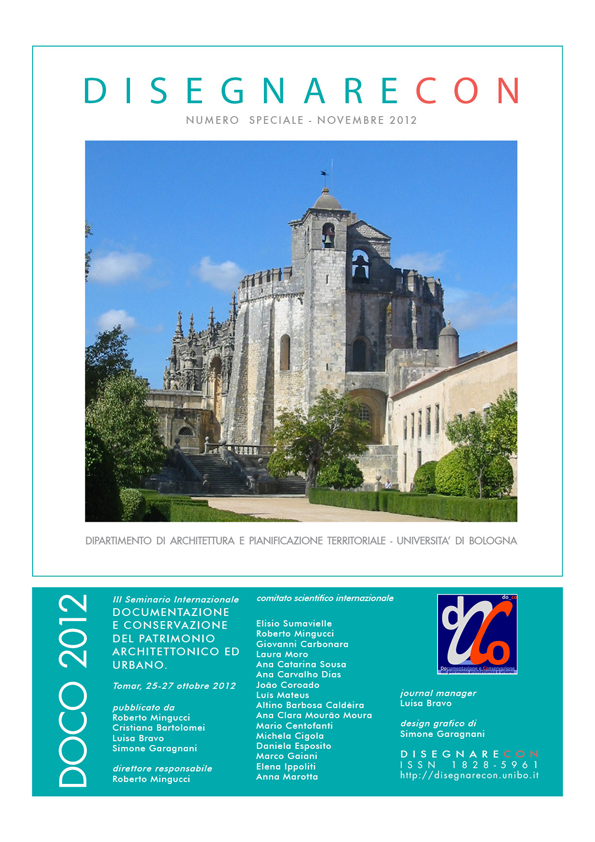SIG na estruturação de sistemas de documentação integrados para gestão de patrimônio histórico com ênfase em rochas ornamentais
DOI:
https://doi.org/10.6092/issn.1828-5961/3296Parole chiave:
SIG, gerenciamento de patrimônio público, integração de dados, rochas ornamentais, mapeamento de monumento, diagnóstico de deterioraçãoAbstract
Analisa estudo de caso do século XIX, da cidade de Serro, Minas Gerais, Brasil: a Chácara do Barão do Serro, que pertencia a um comerciante de diamantes e apresenta trabalho requintado em pedra. O monitoramento do estado de deterioração dos edifícios contém dados georreferenciados e propriedades de diversas áreas do conhecimento, resultando em um sistema complexo, em quatro escalas: territorial, objeto, local e microscópica. Para garantir a acessibilidade e interpretação de dados, um SIG foi estruturado para mapear as propriedades dos elementos. A intenção era mostrar os benefícios do uso de SIG no controle da deterioração do estado das rochas utilizadas em monumentos e propor metodologia de apoio à gestão do patrimônio público, o que permitirá uma abordagem integrada das características, utilização e condições de conservação da pedra nos elementos presentes em edifícios monumentais. A apresentação dos resultados melhora a comunicação entre os diversos setores envolvidos.
Riferimenti bibliografici
Alves B.P., (1966). Região do Serro, Minas Gerais. Bauxita, níquel e cromo. Rio de Janeiro, DNPM/DFPM, Boletim 123: 80-82.
Aires-Barros L., (2001). As rochas dos monumentos portugueses. Tipologias e patologias. Lisboa: Min. Cultura - Inst. Port. Patrim. Arquitetônico, 535 pp.
Bartolomei, C., (2000). Informazione e monitoraggio sulle attivitá commerciali e artigianali nei centri storici, con particolare riguardo alla realizzazione di un sistema informatico multimediale riguardante le attivitá commerciali e artigianali del centro storico di Bologna. (Mídia CD-rom).
COMIG (Companhia Mineradora de Minas Gerais), (2003). Mapa geológico do estado de Minas Gerais. Escala 1:1.000.000. Belo Horizonte: CPRM/COMIG, Meio Digital.
Costa A.G., (2009). Rochas e Histórias do Patrimônio Cultural do Brasil e de Minas. Rio de Janeiro: Bem-Te- Vi, 292 pp.
Fitzner B., (2004). Documentation and evaluation of stone damage on monuments. - In Kwiatkowski, D. & Löfvendahl, R. (ed.): Proceedings of the 10th International Congress on Deterioration and Conservation of Stone, Stockholm, Vol. II, 677-690, ICOMOS, Sweden.
Heinrichs, K. & Fitzner, B., (2007). Stone monuments of the Nemrud Dag sanctuary Turkey - petrographical investigation and diagnosis of weathering damage.- Z. dt. Ges. Geowiss., 158/3. Natural Building Stone Resources - Part 1. 519-548.
Mingucci, R., et al., (2000). Progetto Mura; Recupero e manutenzione del sistema delle fortificazioni di Malta e Della Chiesa di Santa Caterina D’Italia. Bologna, Universitá Degli Studi e Ministero dei Lavori Pubblici di Malta.
Ministério da Cultura-MEC, (2005). Programa Monumenta. Sítios históricos e conjuntos urbanos de monumentos nacionais: norte, nordeste e centro-oeste. Brasília : Ministério da Cultura, Programa Monumenta: vol. I, cadernos técnicos 3: 456 p.
Werneck G., (2008). Serro tem patrimônio histórico revigorado. Jornal do Commercio, Rio de Janeiro.
Zapparoli A.C., (2001). Os Depósitos de Cromita da Borda Leste da Serra do Espinhaço Meridional, Minas Gerais: Petrologia, Quimismo e Implicações Genéticas. Dissertação de Mestrado, Universidade Estadual Paulista, Rio Claro, 133 p.
Downloads
Pubblicato
Come citare
Fascicolo
Sezione
Licenza
Copyright (c) 2012 Ana Clara Mourão Moura, Marcela Mourão Moura, Antônio Gilberto Costa, Mônica Martins Andrade, Lucas Saliba Santos
Questa rivista è distribuita con licenza Creative Commons Attribuzione - Non commerciale 3.0 Unported.





